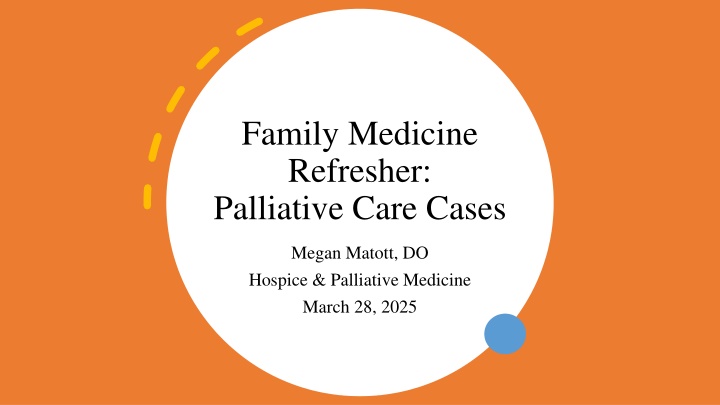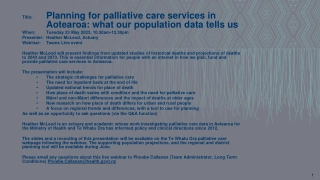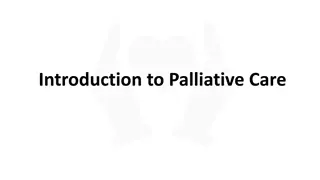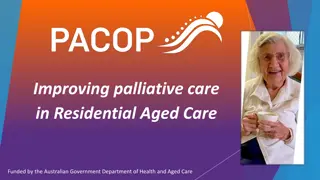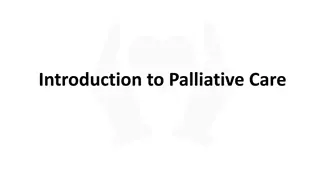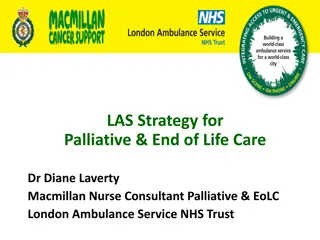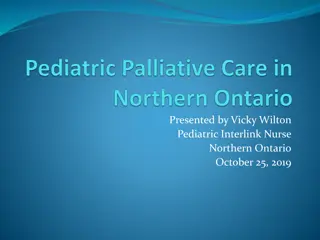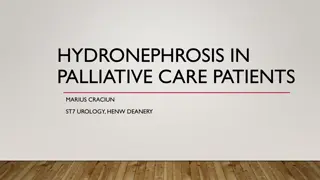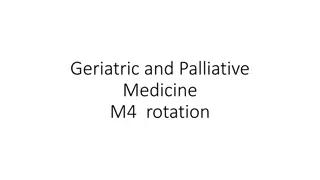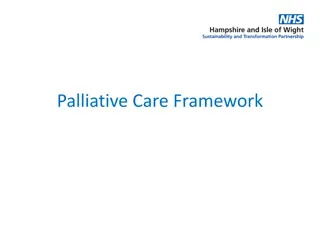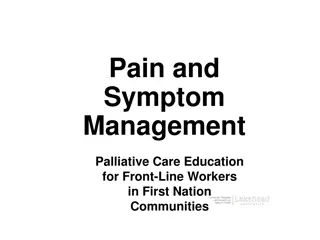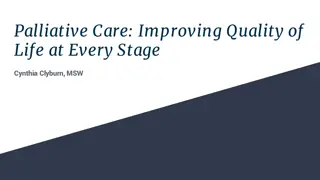Palliative Care: Case Studies & Management Strategies
Explore practical approaches to managing palliative care patients with metastatic colon cancer, addressing symptoms like pain, fatigue, nausea, and loss of appetite. Learn about MOLST completion, comfort care orders, anorexia, cachexia, and pharmacological treatment options for symptom control in advanced cancer patients.
Download Presentation

Please find below an Image/Link to download the presentation.
The content on the website is provided AS IS for your information and personal use only. It may not be sold, licensed, or shared on other websites without obtaining consent from the author.If you encounter any issues during the download, it is possible that the publisher has removed the file from their server.
You are allowed to download the files provided on this website for personal or commercial use, subject to the condition that they are used lawfully. All files are the property of their respective owners.
The content on the website is provided AS IS for your information and personal use only. It may not be sold, licensed, or shared on other websites without obtaining consent from the author.
E N D
Presentation Transcript
Family Medicine Refresher: Palliative Care Cases Megan Matott, DO Hospice & Palliative Medicine March 28, 2025
Session Objectives Review MOLST completion Review Patient Cases: Symptom management Review Typical Comfort Care Orders
Patient Case #1 67F, Metastatic Colon CA, Mets to liver & bone, on CA-directed tx Presents to your OP clinic w complaints of widespread pain, fatigue, nausea, loss of appetite, has lost >5% of her body wt since last seen You adjust her opioids to help combat her pain issues What do we think is going on here? How can we address her fatigue, nausea & decreased appetite?
Anorexia & Cachexia Anorexia = Loss of appetite Pre-Cachexia = anorexia present, loss not >5% of body wt Cachexia = loss of >5% of body wt, along with associated inflammatory state results in poor immunity, QOL, poor outcomes/mortality, SE/toxicities/ responsiveness to dz tx Initial/First Line Treatments: Prevention, NSAIDs (combat inflame state), physical activity (boosts mood, QOL), nutritional support (nutritionist support, +protein, supplements), accommodate food preferences w spices/taste, DC meds that cause low appetite, optimize social supports
Pharmacological Tx of Anorexia & Cachexia Anorexia dt early satiety, NV, dyspepsia, bloating Reglan ATC Anorexia dt insomnia, dep/anxiety Remeron, Zyprexa Anorexia dt pain, fatigue, nausea Steroids/Dex, Dronabinol Anorexia dt Chemotherapy Zyprexa Other Rx considerations: Megace (Megestrol Acetate)-Improves appetite & wt (fluid/fat, no mm gain), same efficacy as steroids, (safter than steroids for long term use), >MJ effectiveness, takes weeks to see effects Beers list for elderly: 1/23 will die: high risk DVT, mm catabolism, adrenal suppression, hypogonadism
Patient Case #2 67F, Metastatic Colon CA, Mets to liver & bone, on CA-directed tx For her fatigue, nausea & decreased appetite you gave her course of dexamethasone for 2 weeks, sx greatly improved A month later, she calls your office dt persistent NV, after failing a couple anti-emetics. You discuss supportive measures, and send her a rx for Haldol, which helps immensely. 2 weeks after that, her Nausea is controlled with Haldol use, and her pain is controlled with her chronic opioids, but she complains of restlessness You see her in your office: where she states she has this uncomfortable sensation of restlessness, feels like she needs to move all the time. In the office she is shuffling her feet and swinging her legs nonstop. It doesn t improve when she gets up to walk around. She states this has been happening day/night. What is going on? What do we do about this?
Acute akathisia Acute akathisia: extrapyramidal sx, uncomfortable sensation of internal restlessness, need to move, no better w movement (unlike RLS), sx occur all day/night Causes: neuroleptics, Reglan, Phenergan, TCAs, SSRI, SNRI, opioids, steroids, anticholinergic rx Higher risk w dopamine blocking rx, IV route, rapid dose titrations Treatment: stop or rotate meds
Nausea & Vomiting Causes: lyte imbalances, dehydration, malnutrition, meds, gastric emptying, constipation Treatments: correct underlying causes, IVF, antiemetics, if refractory schedule ATC antiemetics, use >1 antiemetic agent, interventional procedures if indicated: stenting/venting PEG Empiric antiemetics (if unsure etiology) Mostly nausea dopamine blockers:Haldol/Reglan/Compazine Mostly vomiting Zofran Zyprexa is a good empiric agent to try (less dopamine blockade than haldol)
Nausea & Vomiting: Specific Etiologies Chemo-R Trigger Zone (CTZ): metabolic (uremia, sepsis, lytes, infection) Haldol Cortex: anticipatory NV, high ICP, meningeal/CNS tumors Benzos Peripheral/GI Pathway: meds (iron, antibiotics, NSAIDs, ETOH), constipation, GI bleeding, tumor/obstructions, infections 5HT3-R blockers (Zofran) Vestibular: motion sickness, middle ear/otoliths dt dehydration, ototoxic chemo Anticholinergic/Antihistamines = Meclizine, Benadryl, Phenergan (promethazine), Scopolamine Chemo-induced NV 1stline: Aprepitant (NK-1 R antagonist) along w dex, 2ndline: Zyprexa, 3rdline: Zofran
Patient Case #3 67F, Metastatic Colon CA, Mets to liver & bone, on CA-directed tx You stop her Haldol and rotate her to Zofran. NV remains controlled, and her symptoms of restlessness resolve over the next several days/wks. GI symptoms controlled on PRN Zofran. Pain controlled on PRN opioids. A month later, you see her for follow up, and she complains of feeling okay overall, but has had difficulty with her bowel movements. States when she goes to the bathroom, not much stool comes out, and she only goes every couple days. What should we do about her constipation?
Constipation Treatment of Constipation: hydration, fiber, activity, dc meds, abdo massage, rx Bulking Agents/Fiber: psyllium, methylcellulose, wheat dextrin, polycarbophil, better for active pts w good hydration status Surfactants: softeners -> Docusate, loose/mushy stool (not-preferred) Osmotic Agents: PEG/Miralax, Lactulose (+gas), Sorbitol (+gas), Gylcerin, Mag Citrate, Mag Sulfate (avoid mag in renal dz) Simulants: Bisacodyl (ducolax), senna (no tolerance/addiction) Secretory Agents: Lubiprostone, Linaclotide (Linzess) risk of dehydration Supps: Docusate sp, Bisacodyl sp Enemas: mineral oil, soap suds, fleet (enemas best for fecal impaction if no bleeding/perf) Fleet Enemas: (Na+ Phosphate prep): avoid in renal pts, CHF, cirrhosis, elderly/frail -> intravascular depletion, sig fluid shift, high phosphate, low Ca+, low K+, phosphate neuropathy Preference: Miralax in AM, Senna Nightly, Titrate both up to BID & beyond as needed, before other rx
Patient Case #4 67F, Metastatic Colon CA, Mets to liver & bone, on CA-directed tx Pt started on daily Miralax and nightly senna. She has been taking this for a week, with continued small and infrequent bowel movements. During a telephone follow up, you increase her Miralax to BID. A week later, she reports to the ED with abdominal pain. She is passing gas, Nausea, no vomiting, persistent feelings of constipation. This is her Abdo xray. What now?
Opioid Induced Constipation NO tolerance develops to constipation, onset 5-25mins after rx dose Eval: R/O bowel obstruction, fecal impaction, acute process 1st Treatments: Stimulants (Senna) and Osmotic (Miralax) are 1st line Methylnaltrexone (Relistor): PAMORA (peripherally acting Mu opioid R antagonist) 8mg for pts < 136lb, 12mg for pts >, adjust in renal dz by 50% (CrCl <30) 60% pts - BM in 4hr Expensive Doesn t cross BBB no analgesia loss Avoid in bowel obstruction or in folks w GI tract integrity issues/risk of perf FDA approved in CA or non-CA pts, SE: NV, diarrhea, cramping Naloxone: low dose: 0.8mg BID, some loss of analgesia, some withdrawal
Patient Case #5 67F, Metastatic Colon CA, Mets to liver & bone, on CA-directed tx Patient is treated with a dose of methylnaltrexone, has many bowel movements, and feels tremendously better. She is sent home on a regimen of BID Miralax and senna. During her ED visit, her opioids were also increased, dt ongoing bony met pain. A couple weeks after her ED visit, she calls your office-her pain is well controlled, but she has been having hiccups for 6 days straight, and nothing she has tried has gotten rid of them. She wants to know how this happened and what to do about it?
Hiccups Acute: <48hrs, persistent: <1 month, intractable: > 1 month Freq w age, innumerable causes, meds mcc: opioids, benzos, methyldopa, levodopa, steroids/dex Non-rx Tx: CO2 (hold breath, paperbag), Valsalva, vagal stim, FISS: force inspiration suction and swallow (drink through a coffee straw) is most effective Rx Tx: PPI if reflux, Reglan, Baclofen, (consider gab or Haldol) If folks fail PPI, Reglan, Baclofen, Gabapentin, can try Chlorpromazine (Thorazine), DC rx after hiccups have resolved
Patient Case #6 67F, Metastatic Colon CA, Mets to liver & bone, on CA-directed tx Patient is treated with a slight reduction in her opioids, and a course of baclofen, her Hiccups resolve. She does well for some time. Unfortunately, over the next couple weeks, the pt s functional status worsens. She develops generalized weakness, loss of appetite, more wt loss, and worsening constipation, now with obstipation. She is admitted to the hospital, found to have progression of CA throughout the abdomen, and dx w malignant bowel obstruction. Oncology sees her and offers no further CA- directed therapies. She looks to you, for the next best steps. What options are there for this patient?
Malignant Bowel Obstruction Survival: complete malignant obstructions are not survivable, average ~4-5wks with good supportive care, if lack of sepsis/perforation Surgical Management: if good performance status, local tumor, gives 1-2wks more of life Medical Management: shorter ppx than if surgery could be done NPO, NGT, IVF, fix lytes, antiemetics, liquids for enjoyment if NGT/PEG in place Reglan for partial obstructions, avoid if complete obstruction Secretion management (octreotide), GI secretions & splanchnic blood flow PPI/H2 to reduce upper GI secretions IV Steroids: peritumor inflame/edema Good opioid regimen pain from MBO is chronic, folks often need basal opioids (TDF patch, or continuous PCA, with PRN on top) Venting PEG: when medical mang isn t effective and pt is otherwise non-surgical candidate, helpful if survival is weeks/month, rather than days, caution w ascites: para prior to placement
Patient Case #7 59F with breast CA, stable on CA-directed treatments She presents to your office with complaints of increased pain. She used to just have pain in her breast sp mastectomy, and generalized aches/pains. Now she complains of sig pain in her back, her hips and her R shoulder. You are worried about disease progression, so you order imaging, and find new lesions throughout her spine, pelvis and R arm. You consult with her oncologist, who develops a new chemotherapy plan. How can you help her with this pain?
Pain Management of Bony Mets Bony mets (mc breast, lung, prostate, MM, thyroid, renal CA) ALWAYS Consider palliative Radiation Pain relief from palliative XRT occurs in 1-4 wks, single fraction or hypo-fractionated XRT = best Re-irradiation of bone mets helps 50% of the time, need re-tx if single fraction done originally Pharmacological options: Opioids NSAIDs, Steroids: course of dexamethasone (limited data, reported help) Consider Bisphosphonates: Zoledronic acid & pamidronate (onc will rx these) Other Bony pain thoughts Consider interventional procedures/blocks Claritin: helps w bony pain dt BM stim/rapid cell turnover, heme malignancies, (many chemo regimens cause neutropenia, tx w Neulasta -> causes WBC growth/BM stimulation-> can cause bone pain)
Patient Case #8 59F with breast CA, metastatic to bone, stable on her new CA-directed treatments She decided not to pursue XRT, sx were controlled with a course of dexamethasone and opioids. You see her a couple weeks later, with complaints of anxiety about her situation, and depressive symptoms. She is struggling with the news of her CA progression. What are some treatment options for her anxiety and depressive symptoms?
Anxiety in Palliative Care Patients Anxiety sx 10x mc than GAD, esp at EOL R/o organic causes: meds, steroids, TSH, pain, dyspnea Psychosocial factors/sources: fear death/dying, existential distress, coping deficits, maladaptive PD, undertx sx, withdrawal from sedatives/opioids Meds that cause anxiety SE: caffeine, steroids, nicotine, neuroleptics, stimulants, antidepressants, anti-emetics (reglan, prochlorperazine), phenylephrine (Sudafed), iatrogenic Synthroid Treatments: Non-rx-Explore fears/concerns, coping strategies that worked in past, music therapy, relaxation/guided imagery, hypnosis, mindfulness, psychotherapy (CBT), spiritual support, RX Medications options If ppx in mons/yrs range: SSRI, SNRI If ppx in wks/mos range: benzodiazepines
Depression in Palliative Care Patients Sadness in terminal disease is normal, depression/pervasive sadness/despair is not normal DSM5 Criteria: 5sx, present for 2 weeks, sx interfere w life, no other organic/med cause Depressed mood most of day/almost daily, Markedly diminished interest or pleasure, Unintentional (significant) change in weight, Insomnia or hypersomnia, Psychomotor agitation or retardation, Fatigue or loss of energy, Feelings of worthlessness or excessive/inappropriate guilt, Diminished ability to think or concentrate, Recurrent thoughts of death or suicide Depression in PC pts: purpose, QOL, survival, worse sx, tx adherence, SI, hard on families Treatments: tx sx, CBT, exercise, SSRI/typical rx if ppx >2mos, Psychostimulants if ppx <2mos, Consider Ketamine or ECT in refractory cases if able Stimulants: Fast acting (~2days for effects, DC if no improvement in 1wk), tx fatigue, depression, opioid sedation SE, improve opioid analgesia, ok to use w SSRI, SE: anxiety, cardiac caution w CV dz-can worsen ischemia, CHF, arrythmias Ritalin: 2.5-5mg 1-2x daily
Quick Psych Med Review SSRI: 4-6wks, higher doses for anxiety SNRI: 4-6wks, mood sx, neuropathic pain, (pain benefits seen before mood benefits), better for elderly folks than TCAs, not as sedating-not much benefit for insomnia TCA: tx anxiety/depress, low appetite, pruritus, neuropathic pain, insomnia, (lower doses better for pain/sleep than mood), Avoid in CV dz/prolonged qtc, elderly pts (anticholinergic SE: constipation, dry mouth, orthostatic hypotension - falls, urinary retention) Remeron: tx anxiety/depress (higher doses), anorexia (data is poor, some wt gain seen), nausea (anti- emetic effects), insomnia (more sedating at lower doses dt higher anticholinergic properties @ low doses), doses 30mg or > noradrenergic effects: energizing (dose in AM), increases warfarin levels Wellbutrin: activating, mood/reduces feeling of fatigue, SE: seizure threshold Trazodone: sedating/tx insomnia (lower doses), tx dementia aggression/agitation, SE: SI, falls Ketamine: NMDA R antagonist, topical, nasal, IV, PO Uses: 1 infusion-> depression improvement for 1-2 weeks (limited data), refractory neuropathic pain, reduce opioid use SE: vivid dreams, hallucinations, floating sensation, blunted affect/emotional withdrawal, delirium, HR/BP, NV, anorexia, hyper-salivation, ulcerative cystitis (w abuse)
Patient Case #9 59F with breast CA, metastatic to bone, stable on her new CA-directed treatments She was started on a long-acting SSRI and PRN benzos, which she uses sparingly. Symptoms are well controlled. She calls your office, several months later, with complaints of worsening. She has lost wt, lost her appetite, she has become weaker, and all ADL are now a struggle. She also complains of worsening back pain and tingling in both of her feet. You see her in the office for an acute visit. On exam, she has tenderness along the entire length of her spine, and she has decreased sensation in both of her feet. What should you do next?
Spinal Cord Compression Dx: hx CA w back pain-> urgent non-contrast MRI entire spine, if neuro sx-> STAT, if can t get MRI get CT spine w myelography Tx: after imaging is ordered, before results start stat steroids, sp imaging: stat surgery & rad/onc consults Steroids: load 10-16mg IV dex then 4mg IV q6hrs Surgery >> XRT alone (surg candidates = spinal instability, loss of ambulation <48hrs, single area compression, rad-resistant/unknown CA, good prior functional status) XRT: start w/in 24hrs if able, 90% retain ambulation if no paralysis at dx, if paralysis already-30% regain ambulation, 70% do not regain that function, XRT alone if poor surg candidates Bowel regimen for those w incontinence, senna/miralax Don t send these patients to hospitals that don t have in house Rad/onc & spine surgery, and if you are treating pts with this problem at a hospital that doesn t transfer them
Patient Case #10 59F with breast CA, metastatic to bone, now with spinal cord compression Patient is in the hospital; she was deemed a poor surgical candidate dt her recent rapid decline in functional status. She undergoes XRT and a course of steroids. Unfortunately, during admission she had worsening of her paresthesia, and progressed to complete paralysis of both legs. During IP stay, she continued to have decline in appetite, functional status, and wakefulness. She has declined rapidly, now with markers of multi-organ failure. You have a meeting with her family, whom all agree to transition the patient to comfort care. She is too unstable for discharge home or to a facility. By the time she is transitioned to CC, you believe her ppx is hours/days. What are your standard CC orders?
Comfort Care Basics Comfort Care Orders Tylenol: po, sl, rectal: pain/fever Bowel regimen: po, rectal: Suppository PRN q3 days if no BM Pain/Dyspnea: Opioid q1-4hrs PRN Anxiety: Ativan q1-4hrs PRN Agitation/NV: Haldol q4-6hrs PRN Excessive PO secretions: Atropine drops PO, Subq or IV Robinul, Levsin PO, NO SCOP PATCHES Imminent EOL Signs/Symptoms Loss of alertness/somnolence Slack jaw, hyperextended neck Shallow RR, agonal breathing, Cheyne stokes pattern, apnea Decreased pulses Loss of bowel sounds, oliguria or anuria Cool extremities, mottling/skin changes
Patient Case #11 59F with breast CA, metastatic to bone, now with spinal cord compression and rapid decline in functional status She is now IP on a comfort care plan Nursing reports that she has been uncomfortable all evening, they have given her PRN pain medications, with no success, she is moving around in the bed, moaning, and moving her hands up in the air in a non-purposeful way. Family is at the bedside and very distressed, they ask you what is happening? What can we do about this?
Terminal Agitation/Delirium Tx pain, urinary retention, constipation, repositioning, check for fever, hyperalgesia, etc. If ppx days/wks: Tx with neuroleptics (Haldol) If ppx hrs/days: Tx with Benzos, Neuroleptics if refractory Terminal agitation/delirium is only confirmed after death
Patient Case #12 59M with COPD on home O2, ESRD on HD, and FTT, was admitted to the hospital with aspiration PNA You having been treating him for PNA, but he has escalating O2 needs, and is now in the PCU on 45L of high flow oxygen After many days of treatment, you worry that he may not be able to recover from this resp insult, dt his underlying deconditioning and chronic lung disease After much discussion with him and his family, they ultimately decide to transition him to CC. He has been having dyspnea, while on high flow, and family wants to know how this will be managed when the HFNC is stopped. How do we handle this transition to CC, and removal of the HFNC?
Dyspnea RDOS: Resp distress observation scale Acute dyspnea needs directed tx, Chronic dyspnea occurs despite ongoing tx Total dyspnea psychosocial component (like total pain) TREATMENT: reverse underlying cause if able (PNA w antbx, pleural effusion w thora, tumors w stents/surgery, secretions w rx, spasms w SABA/pulm rx, CHF-fluid overload w diuresis, anemia w transfusion) Global Treatment when direct tx aren t an option/not working Non-Pharm Options 1st line: fan, repositioning (good lung up), reduce exertion, pulmonary rehab, O2 if hypoxic, total dyspnea (breathing training, acupuncture, guided imagery), CPAP/BiPAP/HFNC if consistent w GOC Opioids are 1st line Rx tx when refractory to non-pharm tx Benzodiazepines: only after opioids and non-rx tx have failed Secretions: strong cough: neb saline or guaifenesin, weak cough: atropine, glycopyrrolate Consider proportional sedation if refractory at EOL
Patient Case #13 59M with COPD on home O2, ESRD on HD, and FTT, was admitted to the hospital with aspiration PNA, who has now been transitioned to comfort care With removal of HFNC, he was given HM and Ativan doses, he remained comfortable The next day he has remained mostly somnolent, with limited interaction occasionally will moan/speak a couple words He appears relatively comfortable, however, nursing reports he is scratching himself, he has excoriations on his extremities, and they see him constantly itching. He hasn t had HD the last 3 sessions dt acute illness. Nurses have his skin well moisturized, have given some PRN doses of antihistamine with no relief. What should we try next?
Itching Treat the cause if identifiable Dry mouth: emollients, Atopic dermatitis: topical steroids, tacrolimus Allergic rxn: anti-histamines Anemia: iron/improve anemia Neuropathic: gabapentin, pregabalin Paraneoplastic: Paxil or Remeron (if longer ppx) Liver/Cholestatic: Rifampicin, Naltrexone, Ursodeoxycholic acid, Cholestyramine, Zofran Renal/ESRD: Gabapentin/pregabalin if making urine, Zofran, antihistamines, Naloxone, Topical tacrolimus, topical hydrourea, UVB (light therapy), if longer ppx: sertraline, amitriptyline, doxepin If unsure of etiology: keep skin moisturized, use cooling agents (menthol, calamine), topical anesthetics, anti-histamines, steroids, gaba, paxil, TCA If opioid induced: reduce, rotate, anti-histamines, topicals, Zofran, low dose opioid antagonists if refractory.
Patient Case #14 59M with COPD on home O2, ESRD on HD, and FTT, was admitted to the hospital with aspiration PNA, who has now been transitioned to comfort care You treated him with a multimodal approach, and itching improved A couple days later, he is looking imminent, however, he is incredibly dyspneic, and agitated, you think he has terminal agitation. You have been giving him ATC opioids, PRN benzos and neuroleptics, but he remains very agitated and uncomfortable looking. Family asks if we can sedate him, what should we tell them?
Palliative Sedation Palliative Sedation: goal to tx sig sx @ EOL: delirium, existential distress, dyspnea, pain Eligibility = terminal illness (hrs-days ppx), last resort, pscyh/spiritual assessment done if able, informed consent w pt/fam, DNR/DNI, address artificial nutrition/hydration prior Proportional Palliative Sedation: Goal: sedate to relieve a sx w as little sedation as needed, goal is not to hasten death, done after all other options are tried, including higher risk rx options, consider respite sedation in 24-48hrs, awaken pt and see if better, if not-resedate Continuous Deep Sedation (terminal sedation, palliative sedation to unconsciousness) Goal: sedate until pt is in coma like state, intent to maintain level of sedation until pt dies, continue all other EOL care in addition to sedation Done w bolus rx to initiate coma-> continuous infusions: barbiturate (phenobarbital), benzos, propofol, dexmedetomidine (precedex): Midazolam is drug of choice. NOT done w opioids: escalating doses SE OIN, myoclonus, seizures, opioids are not sedatives, opioids should be kept for pain control though-in conjunction w sedative rx
